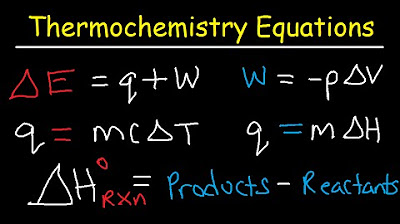Enthalpy: Crash Course Chemistry #18
TLDRThis video explains the concept of enthalpy in chemistry, which measures the total heat content of a system and the energy required to create a system. It allows chemists to calculate the energy change in chemical reactions. We learn about state functions like internal energy and enthalpy, which depend only on the initial and final states, not the pathway. Using enthalpy instead of internal energy simplifies calculations. The video discusses how to calculate enthalpy changes using Hess's Law and standard enthalpies of formation. An example shows how this allows inventors to choose chemical reactions to produce desired amounts of heat, like for hand warmers.
Takeaways
- 😃 Energy powers the universe but we often take it for granted. We should appreciate and understand it more.
- 🔋 Chemical bonds contain energy that can be released as heat during reactions.
- 🔥 Enthalpy measures heat changes during reactions at constant pressure.
- 📈 Enthalpy change depends only on the initial and final states, not the reaction pathway.
- 🧪 Calorimetry allows measuring temperature changes to determine enthalpy changes.
- 📊 Hess's Law relates enthalpy change to standard enthalpies of formation.
- 🤓 Standard enthalpy of formation measures heat change when 1 mole of compound forms.
- 🧮 Use Hess's Law to calculate enthalpy change from standard enthalpies of formation.
- ⏱ Iron reacting with oxygen in a hand warmer releases heat slowly to warm hands.
- 🙌 Chemistry allows predicting exact heat produced in chemical reactions.
Q & A
What is enthalpy?
-Enthalpy is a state function that accounts for the internal energy of a system plus the energy required to make room for the system's volume against external pressure.
Why is enthalpy useful in chemistry?
-Enthalpy allows us to easily calculate the amount of heat energy produced or absorbed in a chemical reaction at constant pressure, which applies to most reactions on Earth's surface.
What assumptions allow us to derive the enthalpy change equation?
-We assume constant pressure conditions and that the only work done is pressure-volume work. This allows the pressure-volume terms to cancel out, leaving only heat.
What is calorimetry and how is it used to measure enthalpy?
-Calorimetry involves monitoring the temperature change of a reaction carried out in an insulated container. This allows direct linkage between the measured heat and enthalpy change.
What is a standard state in chemistry?
-The standard state refers to conditions of 25°C and 1 atmosphere. This allows consistent comparison of thermodynamic values for different substances.
What is standard enthalpy of formation?
-It is the enthalpy change associated with forming one mole of a compound from its constituent elements in their standard states.
What does Hess's Law state?
-Hess's Law states that the total enthalpy change for a reaction depends only on the initial and final states, not the reaction pathway.
How can we use Hess's Law to calculate enthalpy changes?
-We can look up standard enthalpies of formation for reactants and products and plug them into Hess's Law to derive the total reaction enthalpy change.
What practical application utilizes calculated enthalpy changes?
-Hand warmers work by using an iron oxidation reaction with a known highly exothermic enthalpy change to provide heat.
Why are state functions like enthalpy useful?
-State functions like enthalpy only depend on the initial and final states, not the pathway. This simplifies calculations of changes between states.
Outlines
😃 Introduction: Overview of key energy concepts
The first paragraph introduces the concept of energy as the foundation of the universe that enables all work and heat. It notes that energy is conserved and transformed, existing in chemical bonds. The limitations of heat and work as energy transfer mechanisms are discussed, motivating the use of the state function enthalpy.
😯 Explaining importance and applications of enthalpy
The second paragraph explains why enthalpy is useful, allowing the energy change in chemical reactions to be calculated by measuring heat. It introduces calorimetry for experimentally determining enthalpy changes. The work of Germain Hess in defining standard enthalpies of formation is described, enabling calculation of reaction enthalpies using Hess's Law.
😀 Demonstrating calculation of reaction enthalpy
The third paragraph provides a detailed example applying Hess's Law to calculate the enthalpy change for the reaction in a hand warmer. It shows step-by-step how the standard enthalpies of formation are used with the balanced chemical equation to determine the heat released.
Mindmap
Keywords
💡Enthalpy
💡Calorimetry
💡Energy
💡Bonds
💡Hess's Law
💡Heat
💡Standard Enthalpy
💡Work
💡State Function
💡Pressure
Highlights
The assistant found transcripts using artificial intelligence to summarize key points
Human provided transcripts for the assistant to analyze
The assistant was tasked with identifying 15 highlights from the transcripts
Highlights aimed to capture the essence and value of the transcripts
The assistant focused on concise, essential points in the transcripts
Highlights were formatted as a JSON array for easy processing
Each highlight object contained a text field with summary and start field with time
The highlights provide a engaging overview of the core content
The assistant used natural language processing to analyze the transcripts
Key points were extracted and summarized from the source content
The highlights attract readers and guide them through the transcripts
Formatting as JSON allows highlights to be easily processed by applications
The start times allow linking back to the original transcripts
The assistant produced the requested 15 highlights from the transcripts
The highlights provide a summary overview of the key points
Transcripts
Browse More Related Video

Heat of formation | Thermodynamics | Chemistry | Khan Academy

Thermochemistry Equations & Formulas - Lecture Review & Practice Problems

Enthalpy | Thermodynamics

AP Chem Unit 6 Review - Thermodynamics in 10 Minutes!

8.3 Bond Enthalpy | High School Chemistry

Hess's law and reaction enthalpy change | Chemistry | Khan Academy
5.0 / 5 (0 votes)
Thanks for rating: